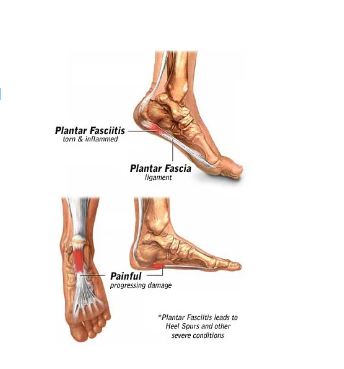Plantar Fasciitis Surgery in NYC

What Is Plantar Fasciitis?
Plantar fasciitis is one of the most common causes of pain in your heels. It’s also a pain to pronounce — “PLAN-ter fash-ee-EYE-tus” doesn’t exactly roll off the tongue. Your plantar fascia is the thick band of fibrous tissue that connects your heel to your toes. Your plantar fascia keeps tension in the arch of your foot. This tissue band can become inflamed and painful and is probably the most common complaint seen in the office of a podiatrist.
All symptoms should always be evaluated with a thorough consultation and examination by your podiatrist for an accurate diagnosis and plantar fasciitis NYC treatment plan to exclude any underlying serious condition. Plantar fasciitis is a painful condition that’s most common as you enter your middle years but can occur in younger active individuals. Our specialists also see the condition in those who spend a lot of time on their feet for prolonged periods of time, such as waiters, grocery, and healthcare workers.
How Do Plantar Fasciitis Start?
Foot care experts report that the most common plantar fasciitis causes are wear and tear. Aging and repetitive activities increase your chances of developing this condition. Some rare cases are the result of single injuries to your foot. When you walk, the tissue stretches when your foot hits the ground. The fascia can become stressed by the way you walk, becoming weak, swollen, or painful over time.
Weight and pressure of any sort aggravate the condition. The bottom of your foot or heel then hurts whenever you stand or walk. If you feel heel pain and suspect plantar fasciitis, seek a confirming diagnosis and appropriate treatment from the best-rated practitioners.
What Are the Plantar Fasciitis Symptoms?
A continued strain of your plantar fascia over time can eventually cause tears in the tissue, resulting in pain and swelling. Any leading podiatry professional can tell you that your chances for plantar fasciitis increase if you:
- Are obese or overweight
- Spend extended periods of time running, walking, or standing on hard surfaces
- Wear ill-fitting shoes. Your shoes should also have enough width and room in them so as not to squash your bunion. If you do develop a bunion, visit our Podiatrists and bunion surgeons in NYC who is trained to correct this deformity and will guide you to the newest bunion procedure that suits your lifestyle and expectations.
- Wear shoes that are well worn
- Have flat feet or high arches
- Develop feet that are pronated — roll too far in when you walk
- Have tight tendons
- Don’t stretch tight calf musclesWear high heels often. That can lead to the development of a bunion
If you suffer from this condition, you feel pain as soon as you get out of bed or sit for a long period of time. Usually, the pain and stiffness lessen after you take a few steps. But your foot may become increasingly more painful as the day goes on. Standing still and climbing stairs can be particularly unpleasant activities. If your feet hurt at night, however, it may be a sign of another problem, like arthritis or a nerve problem such as tarsal tunnel syndrome.
How to Diagnose Plantar Fasciitis?
To diagnose this ailment, your podiatric healthcare professional asks you a series of questions about your plantar fasciitis symptoms and medical history. A best-rated podiatrist performs a series of physical exams that primarily involve watching you while you stand and walk.
Imaging tests, such as X-rays, aren’t helpful when trying to determine your ligaments’ condition. However, X-rays may be used to eliminate the possibility of stress fractures, bone cysts, or other related foot or ankle problems. If you find heel spurs, that doesn’t necessarily mean you have plantar fasciitis.
Tests done in rare cases include MRI, blood work, bone scans, and vascular tests. These may be necessary to evaluate blood flow to your feet and legs. Your podiatry specialists may even order a series of neurological tests to rule out nerve entrapment.
Read more: https://www.footdoctorpodiatristnyc.com/treatment/plantar-fasciitis/
To consult with the top foot doctors or to schedule an appointment with the best podiatrists in NYC, please contact our Upper East Side NYC office by number 212-389-1886.
Manhattan Foot Specialists
983 Park Avenue, Ste 1D14,
New York, NY 10028
212-389-1886
Web Address https://www.footdoctorpodiatristnyc.com/
Upper East Side Office: https://www.footdoctorpodiatristnyc.com/upper-east-side/
Our location on the map: https://goo.gl/maps/WjiEhPH6ydZxPGHfA
https://plus.codes/87G8Q2HR+7R New York
Nearby Locations:
Upper East Side
Yorkville, Manhattan Valley, Lenox Hill, Sutton Place, Carnegie Hill, East Harlem
10021, 10022, 10025, 10028, 10029
Working Hours Union Square & Upper East Side:
Monday: 8AM – 7PM
Tuesday: 8AM – 7PM
Wednesday: 8AM – 7PM
Thursday: 8AM – 7PM
Friday: 8AM – 5PM
Saturday: Closed
Sunday: Closed
Payment: cash, check, credit cards.
